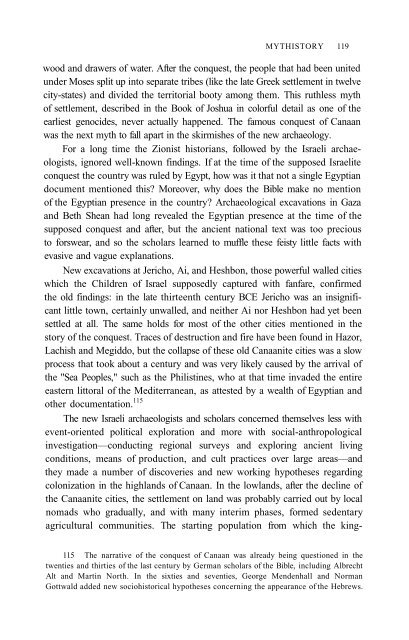Shlomo Sand, The Invention of the Jewish People - Rafapal
Shlomo Sand, The Invention of the Jewish People - Rafapal
Shlomo Sand, The Invention of the Jewish People - Rafapal
You also want an ePaper? Increase the reach of your titles
YUMPU automatically turns print PDFs into web optimized ePapers that Google loves.
MYTHISTORY 119<br />
wood and drawers <strong>of</strong> water. After <strong>the</strong> conquest, <strong>the</strong> people that had been united<br />
under Moses split up into separate tribes (like <strong>the</strong> late Greek settlement in twelve<br />
city-states) and divided <strong>the</strong> territorial booty among <strong>the</strong>m. This ruthless myth<br />
<strong>of</strong> settlement, described in <strong>the</strong> Book <strong>of</strong> Joshua in colorful detail as one <strong>of</strong> <strong>the</strong><br />
earliest genocides, never actually happened. <strong>The</strong> famous conquest <strong>of</strong> Canaan<br />
was <strong>the</strong> next myth to fall apart in <strong>the</strong> skirmishes <strong>of</strong> <strong>the</strong> new archaeology.<br />
For a long time <strong>the</strong> Zionist historians, followed by <strong>the</strong> Israeli archaeologists,<br />
ignored well-known findings. If at <strong>the</strong> time <strong>of</strong> <strong>the</strong> supposed Israelite<br />
conquest <strong>the</strong> country was ruled by Egypt, how was it that not a single Egyptian<br />
document mentioned this? Moreover, why does <strong>the</strong> Bible make no mention<br />
<strong>of</strong> <strong>the</strong> Egyptian presence in <strong>the</strong> country? Archaeological excavations in Gaza<br />
and Beth Shean had long revealed <strong>the</strong> Egyptian presence at <strong>the</strong> time <strong>of</strong> <strong>the</strong><br />
supposed conquest and after, but <strong>the</strong> ancient national text was too precious<br />
to forswear, and so <strong>the</strong> scholars learned to muffle <strong>the</strong>se feisty little facts with<br />
evasive and vague explanations.<br />
New excavations at Jericho, Ai, and Heshbon, those powerful walled cities<br />
which <strong>the</strong> Children <strong>of</strong> Israel supposedly captured with fanfare, confirmed<br />
<strong>the</strong> old findings: in <strong>the</strong> late thirteenth century BCE Jericho was an insignificant<br />
little town, certainly unwalled, and nei<strong>the</strong>r Ai nor Heshbon had yet been<br />
settled at all. <strong>The</strong> same holds for most <strong>of</strong> <strong>the</strong> o<strong>the</strong>r cities mentioned in <strong>the</strong><br />
story <strong>of</strong> <strong>the</strong> conquest. Traces <strong>of</strong> destruction and fire have been found in Hazor,<br />
Lachish and Megiddo, but <strong>the</strong> collapse <strong>of</strong> <strong>the</strong>se old Canaanite cities was a slow<br />
process that took about a century and was very likely caused by <strong>the</strong> arrival <strong>of</strong><br />
<strong>the</strong> "Sea <strong>People</strong>s," such as <strong>the</strong> Philistines, who at that time invaded <strong>the</strong> entire<br />
eastern littoral <strong>of</strong> <strong>the</strong> Mediterranean, as attested by a wealth <strong>of</strong> Egyptian and<br />
o<strong>the</strong>r documentation. 115<br />
<strong>The</strong> new Israeli archaeologists and scholars concerned <strong>the</strong>mselves less with<br />
event-oriented political exploration and more with social-anthropological<br />
investigation—conducting regional surveys and exploring ancient living<br />
conditions, means <strong>of</strong> production, and cult practices over large areas—and<br />
<strong>the</strong>y made a number <strong>of</strong> discoveries and new working hypo<strong>the</strong>ses regarding<br />
colonization in <strong>the</strong> highlands <strong>of</strong> Canaan. In <strong>the</strong> lowlands, after <strong>the</strong> decline <strong>of</strong><br />
<strong>the</strong> Canaanite cities, <strong>the</strong> settlement on land was probably carried out by local<br />
nomads who gradually, and with many interim phases, formed sedentary<br />
agricultural communities. <strong>The</strong> starting population from which <strong>the</strong> king-<br />
115 <strong>The</strong> narrative <strong>of</strong> <strong>the</strong> conquest <strong>of</strong> Canaan was already being questioned in <strong>the</strong><br />
twenties and thirties <strong>of</strong> <strong>the</strong> last century by German scholars <strong>of</strong> <strong>the</strong> Bible, including Albrecht<br />
Alt and Martin North. In <strong>the</strong> sixties and seventies, George Mendenhall and Norman<br />
Gottwald added new sociohistorical hypo<strong>the</strong>ses concerning <strong>the</strong> appearance <strong>of</strong> <strong>the</strong> Hebrews.




